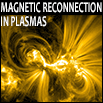Speaker
Mr
Chris Elenbaas
(University of Amsterdam)
Description
Transient giant gamma-ray flares comprise the most extreme radiation events to have been
observed from magnetars. Developing on (sub)millisecond timescales and expelling vast amounts of
energy within a mere fraction of a second, the initial phase of these extraordinary bursts present a
significant challenge for candidate trigger mechanisms. Here we revise and critically analyse the
spontaneous growth of the relativistic tearing instability in a global magnetospheric current sheet as
the trigger mechanism for giant gamma-ray flares. Our main constraints are given by the observed
emission timescales [e-folding rise time, peak time (time from the onset of the flare up until the
photon flux peaks), and spike time (duration of the initial spike)], the energy output of the giant
flare spike, and inferred dipolar magnetic field strengths. From pressure balance and energy
conservation considerations we derive a typical current sheet thickness 10^4 cm and height of the
reconnection region 10^7 cm, which results in an average reconnection speed (rate at which field
lines are advected into the diffusion region) 10^(-3)c for the three observed giant flares. We further
discuss the viability of the assumption that the e-folding emission timescale may be equated with
the growth time of an MHD instability; it is not self-evident that the radiation would be generated
and escape from the system simultaneously as the instability develops.
Primary author
Mr
Chris Elenbaas
(University of Amsterdam)
Co-author
Dr
Anna Watts
(University of Amsterdam)

